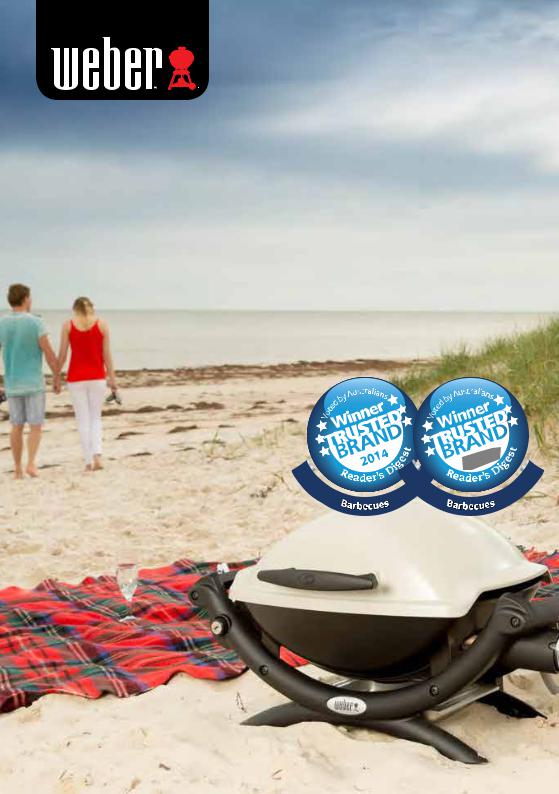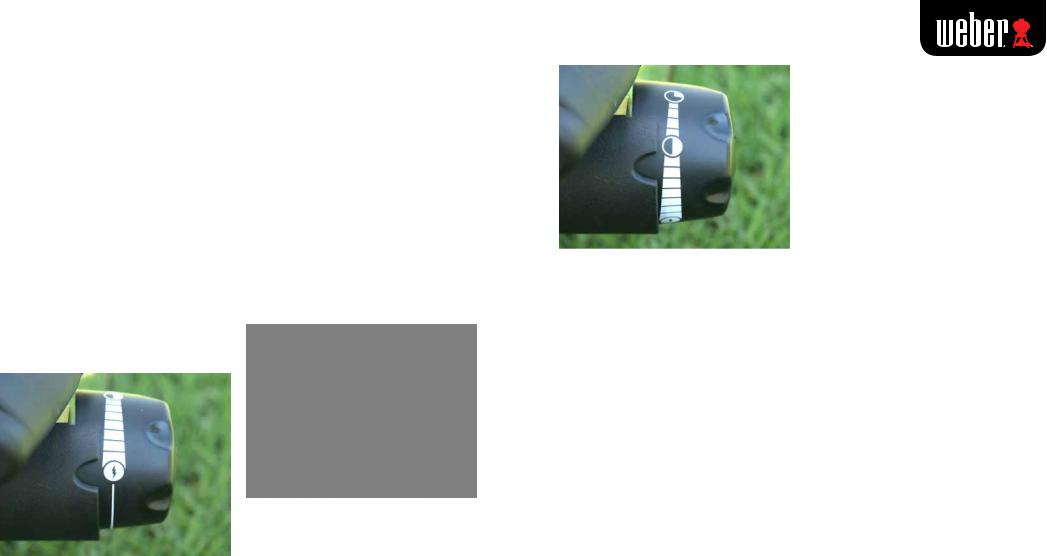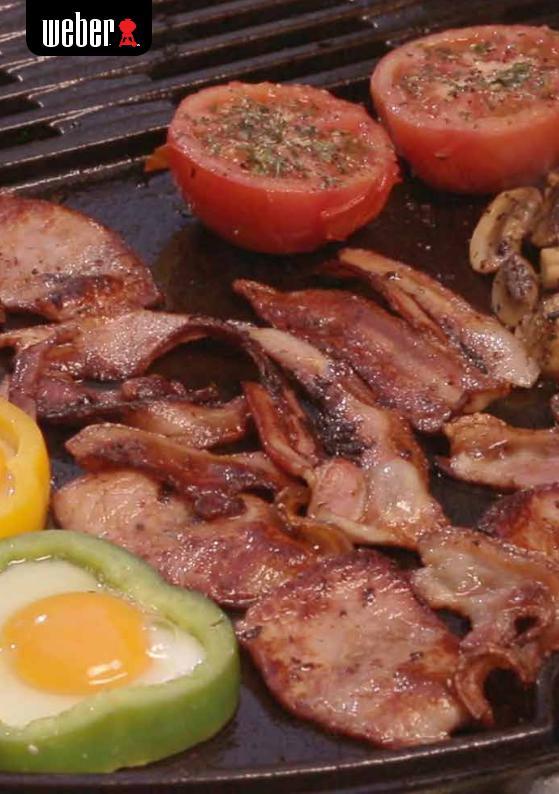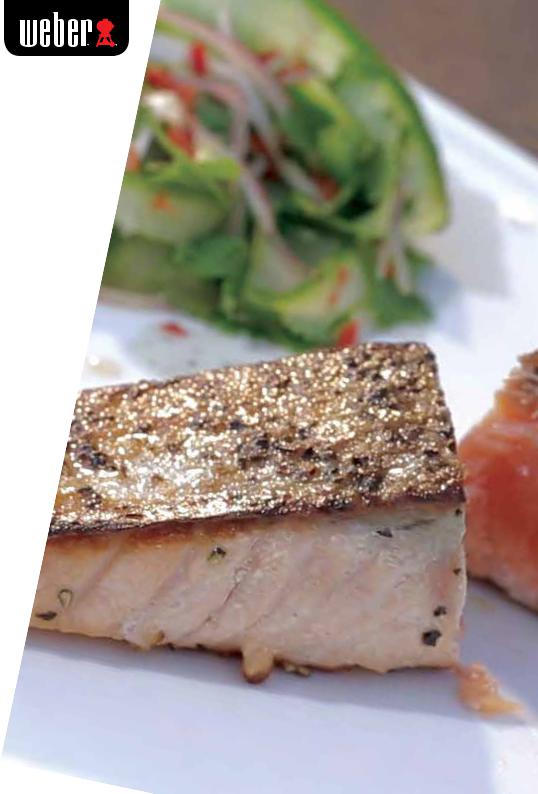Weber baby Q Installation Manual

Cooking with the
Weber® baby Q™ for Australia and New Zealand

WARRANTY
Weber-Stephen Products Co (Aust.) Pty Ltd care of R McDonald Co Pty Ltd of 104 South Terrace, Adelaide, SA 5000, Telephone: (08) 8221 6111, Facsimile: (08) 8221 6211 weber@weberbbq.com.au and Weber-Stephen Products New Zealand care of R McDonald Co. New Zealand Ltd of 6 Maurice Road, Penrose, Auckland, 1643, Telephone: 0800 493 237, webernz@xtra. co.nz, hereby warrants to the original purchaser of the Weber Barbecue (providing it is assembled and operated in accordance with the printed instructions accompanying it) that it will be free from defects in material and workmanship from the date of purchase.
1.a) Aluminium castings 5 years
b)Paint 2 years
c)Igniter 5 years
d)Burners 5 years
e)Cooking grill 5 years
f)Thermoplastic and thermoset parts (excluding fading) 5 years
g)All remaining parts 2 years
Weber shall at no cost to the consumer, upon such defects occurring, at its option repair or replace such faulty materials or workmanship.
Our goods come with guarantees that cannot be excluded under the Australian Consumer Law. You are entitled to a replacement or refundforamajorfailureandforcompensation for any other reasonably foreseeable loss or damage. You are also entitled to have the goods repaired or replaced if the goods fail to be of acceptable quality and the failure does not amount to a major failure.
This limited warranty does not cover any defects, failures, operating difficulties or damage caused due to accident, abuse, misuse, alteration, misapplication, improper installation, connection of any other apparatus other than authorised Weber products, improper maintenance or service or failure to perform normal and routine maintenance.
Weber may require proof of the date of purchase of the Weber barbecue and therefore the consumer should retain the sales docket and return the Weber Customer Care Card immediately.
The benefits conferred by this warranty are in addition to all the other rights and remedies to a consumer under the Commonwealth of Australia Competition and Consumer Act 2010 or other Commonwealth or State legislation and this warranty does not purport to limit or exclude such rights and remedies.
THANK YOU FOR PURCHASING A WEBER® BABY Q BARBECUE
We know you will quickly begin to enjoy many memorable barbecued meals on your Weber Q. To help you get started we’ve included this Weber Q cooking guide which includes some of our favourite recipes. To get the best results, you need to use the correct heat settings as shown in the barbecuing and roasting instructions. In addition to the recipes, you’ll find a ‘barbecuing and roasting guide’ on the last few pages. This provides an estimate of the cooking times for many of the dishes you may like to try.
If you need advice or would like some help you can either call us on:
1300 301 290 (Australia)
0800 493 237 (New Zealand) or email us at:
custserv@weberbbq.com.au (Australia) webernz@extra.co.nz (New Zealand)
You’ll find the people in our company will go out of their way to help you.
If you would like to fill in your warranty details or need information about any of our barbecues or accessories visit our website at www.weberbbq.com.au (Australia) www.webernz.co.nz (New Zealand)
Thank you again, and happy Weber-Q-ing.
CONTENTS
How to get the best from your Weber® baby QTM |
2 |
Helpful hints for the Weber baby Q |
3 |
Recipes
Sunday Breakfast |
7 |
Salmon Fillet with Crispy Skin & Thai Cucumber Salad |
9 |
Meat Lovers Pizza |
11 |
Porterhouse Steaks |
13 |
Prawn Satay with Peanut Dipping Sauce |
15 |
Greek Style Roast Leg of Lamb |
17 |
Roast Chicken |
19 |
Baked Snapper |
21 |
Traditional Bread and Butter Pudding |
23 |
Roast Turkey Breast Roll |
25 |
Barbecuing and Roasting Guide |
26 |
Weber baby Q Accessories |
29 |

How to get the best from your Weber® Baby Q™
Barbecuing
Your baby QTM has been designed to cook magnificent steaks. To get the best results with steak, cook on the grill bars rather than on a hotplate. Only use a hotplate when there is the potential for a lot of fat to come away from the meat or when cooking eggs, pancakes and the like. When a recipe in this cooking guide requires you to ‘barbecue’, it is recommended that you turn the meat only once, halfway through cooking. Always barbecue with the lid closed, these barbecues are not designed to cook with the lid up. Even when cooking on a hotplate always cook with the lid down.
Whether you are barbecuing meat on the grill or on the breakfast plate, it is important that you preheat the barbecue before cooking. The instructions for pre-heating your baby Q follow.
Preheating and barbecuing
To preheat your baby Q, open the lid, unfold the work surfaces and turn the burner control knob to START/HI (photograph A). Immediately press the ignition button to light the barbecue.
Roasting and baking
When a recipe in this book requires you to ‘roast’ or ‘bake’, it is recommended that you remove the hotplate (if you have one), place both cooking grills in the barbecue and use a baby Q convection tray and baby Q trivet. The convection tray and trivet will transform your baby Q from cooking in barbecue mode to oven mode in seconds. The convection tray is engineered with vents designed to circulate the heat perfectly all around the food. The vents allow the fat from the roast to drain away, falling between the grill bars and into the drip pan below.
To set up your baby Q for roasting and baking, place a convection tray on the grill so the four locating tabs sit inside the covered area of your cooking grill. The tray should now be positioned in the middle of your baby Q cooking grill. Place the baby Q trivet on the tray (photograph B). You are now set up to roast or bake.
B
|
When roasting or baking you must preheat the |
|
barbecue. The instructions for preheating the |
A |
baby Q for roasting and baking follow. |
|
Once alight, close the lid and allow the barbecue to heat up for 10 to 15 minutes. Your baby Q is now preheated and ready for barbecuing. Leave the burner setting on START/HI throughout the barbecuing process. Remember to always cook with the lid down. If you are cooking with a hotplate, allow 10 to 15 minutes for it to heat up. Always preheat the plate with the lid down and test it with a droplet of water to make sure it’s hot enough to cook on. For more information on barbecuing and using a hotplate on your baby Q, have a look at the videos on our website at www.weberbbq.com.au (Australia) www.webernz.co.nz (New Zealand)
Preheating and roasting or baking
To preheat your baby Q, open the lid and place the convection tray and trivet in position. Turn the burner control knob to START/HI (Photograph A). Immediately press the ignition button to light the barbecue. Preheat the barbecue for 10 minutes with the burner control knob on START/HI and the lid closed. Once your baby
QTM is preheated, turn the |
burner control |
knob to the roast setting |
(Photograph C). |
Your baby Q is ready for roasting and baking. You can now place your food inside the baby Q. Continue cooking using these settings until the end of the cooking time. Unlike an indoor oven, your baby Q uses natural convection, allowing you to
2 cook at higher temperatures.
C
This is how your baby Q is able to produce such wonderful, flavoursome roasts and that’s why it is essential to use a convection tray and trivet when roasting with these settings. It is normal for there to be a slight drop in temperature when you open the lid and put your food in the barbecue. Don’t worry; the temperature will rise again over the cooking time. Remember, there is no need to turn the meat when roasting, so try not to open the lid unnecessarily. For more information on roasting and baking on your baby Q, have a look at the videos on our website at www.weberbbq.com.au (Australia) www.webernz.co.nz (New Zealand)
Roasting tip
Getting the timing right so that your roast is cooked to your liking can be difficult at times when cooking outside. Wind, ambient temperature and the temperature of the meat when you start cooking all influence the amount of time a roast needs to be cooked.
One of the best ways to make sure you get your roast cooked just the way you like it is to use a meat thermometer. With a standard meat thermometer you can read the internal temperature of the meat, so you can tell when it’s cooked to your liking. An internal meat temperature cooking chart is included in the ‘Barbecuing and roasting guide’ at the end of this booklet.
Helpful hints for the Weber baby Q Always cook with the lid closed
No matter whether you are cooking a roast,
a barbecue |
or breakfast |
on a hotplate, |
always cook |
with the lid |
closed. Why? |
First, cooking with the lid closed creates natural convection of the air inside the barbecue. This 3
results in more even cooking with more natural juices retained.
Second, you will achieve outstanding barbecue flavour that you can’t get by cooking with the lid open. This is produced when barbecue smoke is circulated all around the meat, imparting a beautiful smokey flavour.
Third, cooking times are greatly reduced (about half of what you might expect on an open barbecue), which means you can barbecue the same amount using a lot less gas. As less gas is required to cook the food, you don’t need to fill the gas bottle anywhere near as often (a 9kg gas bottle will last for over 45 hours of cooking).
Use ‘natural convection’ to get the best results
Remember, these barbecues use natural convection to cook food perfectly. To assist convection, try not to cover more than two thirds of the cooking grill at one time. Whilst they will cook with the whole cooking surface covered, the results are far better if you barbecue in two or three batches when feeding a crowd.
When roasting, make sure the height of your food fits inside with the lid closed. To allow the air to circulate properly you should use a convection tray and Q trivet and make sure you have clearance between your food and the lid.

How often should you turn the meat?
Your baby Q™ will produce the most impressive food when you let the ‘convection process’ do its work with minimum interruption. For this reason, resist the temptation to continually turn the food. Each time you turn the food you have to raise the lid, allowing the hot air to escape. When barbecuing meat, outstanding results are achieved if you use tongs to turn the meat (once only) halfway through the cooking time. Roasts, on the other hand, should never need turning.
Food sticking to the grill
When barbecuing food, the meat can sometimes stick to the hot grill. If the meat is properly branded (2½ to 3 minutes) before you turn it, it will not stick. People trying to turn the meat too early often have this ‘sticking’ problem. Don’t tear it, just leave the meat where it is and it will come free once properly branded.
Using sauces and glazes
Only apply sauces or glazes that have a high sugar content during the last 10 to 15 minutes of cooking. If applied too early they will spoil the food, because the sugar in the glaze will caramelise and turn black.
Regular cleaning is necessary
Allowing lots of fat to build up inside the barbecue below the cooking grill can result in a fat fire. If excess fats are cleaned away every four or five times the barbecue is used this should never be a problem. If you ever do have a fat fire turn the gas off at the gas bottle and open the lid to let the heat escape. Remove the food. Do not throw water on the fire, just allow the fire to burn out with the lid up. It could burn for five or ten minutes.
For more informaton on cleaning your baby Q have a look at the videos on our website at www.weberbbq.com.au (Australia) www.webernz.co.nz (New Zealand)
How to clean your cooking grill quickly
The cooking surface on your Weber® Q is easy to clean. For day to day cleaning the best method is to use a Weber grill brush. After preheating the barbecue on high for 10 minutes, use a grill brush to scrape any solid debris from the cooking grill. Use a pair of long handled tongs to rub a damp cloth or paper towel over the grill bars to remove any excess grease. Your Q cooking grill is now ready to cook on.
Troubleshooting Problem. Meat tastes stewed and lacks expected barbecue flavour.
Solution. Temperature is not hot enough. Make sure that you preheat your barbecue as directed under ‘barbecuing’ on page 2. Always cook all food with the lid closed.
Problem. Food does not cook in the estimated cooking time.
Solution. Temperature is not hot enough. Make sure that you preheat your barbecue as directed under ‘barbecuing’ on page 2. Always cook all food with the lid closed.
Problem. Strong wind blows gas flame out. Solution. Turn off gas and allow 5 minutes before relighting. If possible move your barbecue to a position that is protected from the wind. If this is not possible, face the back of your barbecue into the wind, so that the wind cannot blow into the barbecue through the air vents on either side.
Problem. The gas will not relight after you’ve been cooking.
Solution. The barbecue needs to cool down a bit, so that the gas is not carried away from the igniter by heat rising. Turn off the gas and allow 5 minutes before relighting.
Problem. Flame doesn’t travel all the way around the burner, therefore not producing even heating of the grill.
Solution. Hole(s) in the burner tube may be blocked by something that has fallen from above. Lift out the cooking grill and use a paper clip or safety pin to clean out any residue from the burner holes.
Problem. Black residue from the cooking grill sticks to the meat.
Solution. Ensure that the cooking surface is clean before you start barbecuing (see ‘How to clean your cooking grill quickly’ on page 4).
Problem. Black smoke is coming from the barbecue. Solution. Black smoke is a sure sign that there is a fire inside your barbecue (see ‘Regular cleaning is necessary’, page 4). Grey smoke is fine, this grey smoke imparts flavour to your food.
4
Practise Weber® baby QTM safety
•Follow the instructions in your Weber Q owner’s manual for safe lighting and operating your barbecue.
•Keep your barbecue at least 60cm from any combustible materials, including your house, garage, deck railing, etc.
•Never use a barbecue indoors – that includes a garage or enclosed patio.
•Keep sleeves and garments at a safe distance from the heat.
•If for some reason you ever have a fat fire, turn off the gas at the bottle and open the lid, then stand away. Never pour water on a fat fire.
•Never use the barbecue on a boat. Bottled gas is denser than air and can accumulate in the bottom of the boat.
•Keep children and pets a safe distance away from the barbecue when it is hot.
•When you’ve finished cooking, turn off the barbecue at the burner control and at the gas bottle. If your barbecue is on natural gas turn off the barbecue at the burner control knob and disconnect the hose at the bayonet fitting.
•Before you start cooking check and empty any accumulated fat from the aluminium tray located below the barbecue.
Food safety
•Wash your hands thoroughly with soap and hot water before starting any meal preparation, and after handling fresh meat, fish or poultry.
•Thoroughly defrost foods in the refrigerator, not on the bench top.
•Use a clean spatula or tongs to remove food from the barbecue.
•Never place cooked food on the platter that was used to carry the uncooked food to the barbecue.
•Always cook minced meats until they are at least medium (71°C internal temperature) and poultry until well done (74°C).
Cooking times
In this cooking guide each recipe has the estimated cooking time included. In addition, pages 26 to 28 are a general guide to help you with cooking times for other cuts and thicknesses of meat.
Barbecuing and roasting times listed in this guide are approximate. You may have to allow more time or use more heat on cold or windy days.
Try using a timer; you’ll find it really handy. It’ll give you a reminder when your barbecue is preheated, when your meat needs turning, and when the meat is likely to be cooked.
5

SUNDAY BREAKFAST
Barbecue on Hotplate
Ingredients
Eggs
Bacon rashers
Sausages (optional)
Tomato halves
Method
You will need an oiled hotplate (accessory). If cooking sausages, place them on the preheated hotplate for 6 to 8 minutes with the lid down. Turn them only once or twice.
Add the eggs, bacon and the tomato halves (flat side down) and continue cooking for 3 to 4 minutes, or until the cooked to your liking.
7

SALMON FILLET WITH CRISPY SKIN & THAI CUCUMBER SALAD
Barbecue on Hotplate
Ingredients
Salmon fillet pieces with skin on, 200g to 250g each and about 50mm thick Olive oil
Salt
For the salad
2 continental cucumbers ½ cup chopped coriander
6 large shallots, sliced thinly
1 medium red chilli, seeded and finely diced
1 tablespoon brown sugar
1 tablespoon fish sauce
1 tablespoon fresh lime juice
2 tablespoons rice wine vinegar
2 tablespoons peanut oil Freshly ground black pepper
Method
Lightly brush the salmon fillets all over with olive oil. Season with salt.
Barbecue the salmon on the hotplate, skin side down, for 4 minutes. Turn the fillets and barbecue for another 2 or 3 minutes.
To make the salad: Peel the cucumbers. Use a vegetable peeler to slice strips of cucumber from one end to the other. Discard the centre seeds.
Place cucumber in a colander and allow to drain for around 30 minutes.
Toss cucumber with the chopped coriander, shallots and chilli, and set aside until ready to serve.
To make the dressing, in a bowl dissolve the brown sugar in the lime juice and fish sauce, then whisk in the vinegar. Season with black pepper and add the peanut oil. Mix well before pouring over salad to serve with salmon.
9
